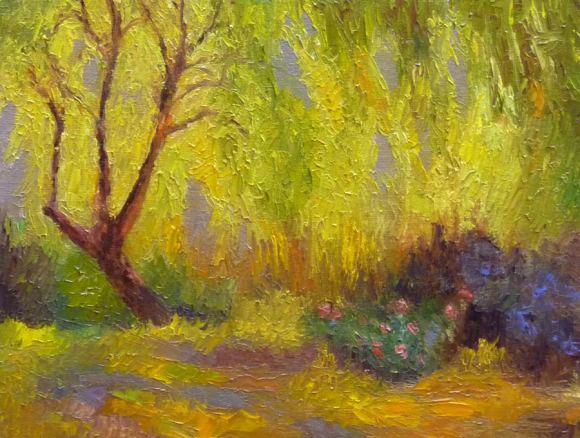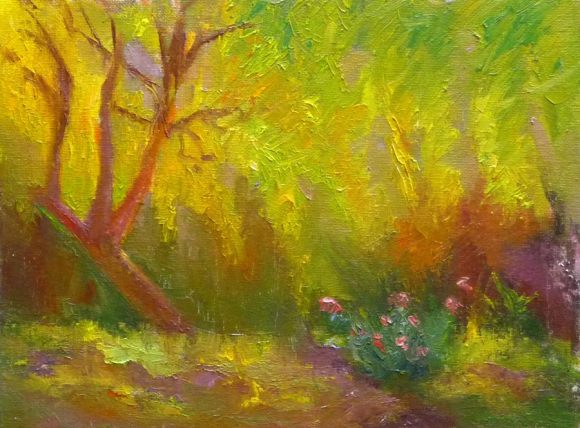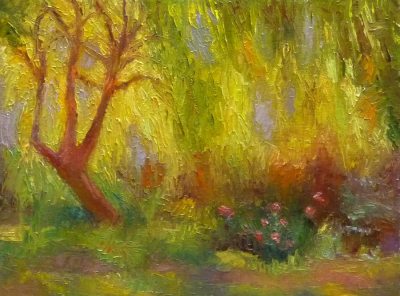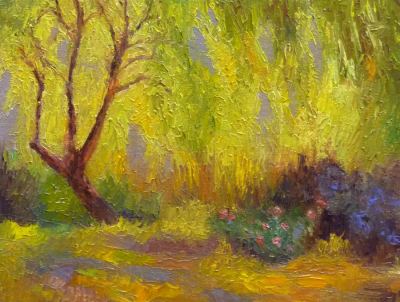
An artist friend once said that in her opinion, the definition of ” plein air” is “bad landscape painting.” While I have seen some really great plein air landscapes, I’m finding that its challenges often lead to results that look clunky and kindergartenish. It takes a lot of practice to be able to successfully capture a scene in the two hour window you have before the light changes and everything looks completely different.
When starting a plein air painting (or any painting for that matter) it is recommended to first simplify the scene down to its most basic elements, the largest shapes of value and color. However, because I love detail so much, something inside me often rebels at simplifying and then I find myself with an incoherent mess.
I like to think of plein air painting as akin to figure drawing, rather than a way to achieve finished works of art: It’s good for you, but not an end in itself. But if I spend my painting time mostly working plein air, I end up with lots of crappy paintings and frustration from working small. And that leads to messing around with the painting at home instead of leaving it alone.
Painting process
Below is the sketch that I painted at Lake Temescal on Sunday. It was a gorgeous day and although the lake was smooth and reflective and beautiful, the backlit trees along the lake were calling out to be painted. Below is the original version of the scene painted plein air.

When I brought it home I broke my rule (that I have yet to follow): Leave plein air paintings alone, call them sketches and move on. Instead, after dinner I started messing with it, using a photo reference.
Today I studied the painting, still dissatisfied, trying to figure out what was wrong. I converted photos of the scene and my painting to “grayscale” in Photoshop and compared them. Immediately I could see that the photo had strong value contrast and that my painting did not. I worked on it some more, adding some dark accents. Here are the photos:
When a painting isn’t working I turn it into a little laboratory for learning, pushing it until it’s total crap or I’ve learned what I was trying to learn, or both. I think I should have just left this one as a happy color study.







11 replies on “Plein air painting: What’s it good for?”
Hi Jana,
I took a workshop recently in which the teacher said that her plein air paintings were, to a large part, for gathering color information directly from the scene. She uses them as reference for larger studio paintings. Kevin MacPherson does the same. I would like to have the equanimity to see my plein air paintings in such a practical, non-judgmental way as those two teachers. They are both excellent artists but still they see the p-a stage as part of a larger process rather than an end in itself. It really is tempting to fiddle around later and try to create what might have been.
LikeLike
It’s definitely a learning experience. I like the comparison to life drawing, because it’s true for both that sometimes you strike gold and sometimes you don’t.
Your posts are a learning experience in themselves, for me at least. Thanks for sharing your experiences.
LikeLike
Jana, I see great worth in both versions. Plein air is HARD – but there is nothing bad, clunky or kindergartenish here. Monet would be smiling.
LikeLike
I stick to my opinionated definition, but it’s great that you are trying. I think if you love detail so much, paint something upclose (or include a foreground in the landscape) so that you can deal with the detail. The colors are great in this, but you only have a midground – where it’s difficult to include detail.
Have you seenPatricia Tobacco Forrester’s landscapes? On one hand, I wouldn’t call them plein air, but I read that she actually paints these outside, so they officially are. Just a thought.
LikeLike
You mean you get two whole hours before the light changes? I’m lucky if I get 10 minutes!
I do sketches – rather than paint – so I can get more done. I do them to get colour information. I’d love to paint out doors but I think I’d need to move the UK as it’s too likely to rain at the moment.
Jana – I’m looking at your paintings and the first thing I noticed was the size of your brush. You can’t be detailed with a big brush – you have to simplify. (I have to do the same thing when I use big pastel sticks)
Why not try painting with a MUCH BIGGER brush and see what difference it makes to your plain air paintings?
LikeLike
I agree with Casey, that your posts are such a learning experience. I’m loving all these pictures side by side so
we can share in your journey. And I like seeing the color
photo of the scene that excited you to begin with– now
it’s captivated me!
annie
LikeLike
Plein air is certainly no religion, even though some artists act as if they think it is. Rather, it’s a part of the process and only to the extent that it benefits the artist.
Each of us has to find what works best for us as artists. For me, plein air serves to give me a feeling for the place, to gather color studies and perhaps to start a painting, but not always.
I say go with whatever our innards tell us we need to do. After all, it’s the painting that counts, not where it was done.
And by the way, I’m so glad I found your blog.
LikeLike
Gosh, When I looked at the first painting I thought to myself “I really like this painting. I like the texture and the light going through the trees”. Then I read that you weren’t happy with it. Hmmmm… I think is is a good study. I learn from your feeling of failure.
LikeLike
Just like cutting down on my tea drinking, plein air too fills me with dread. I cannot even imagine that you get any pleasure from that – but then I’m reclusive!
LikeLike
Well, hate to disagree most of the time…but so many remarks here, seem to “delete” the spirit of plein air painting….yes, these can be merely used as color studies for larger studio pieces….BUT!!!
THE SPIRIT of a painting, is often “captured” while on the route of DISCOVERY!!! BUT in the end, all art is really about what is in one’s heart! and Spirit!! I have seen pieces with little understanding of art principles that have GREAT SOUL….and I have seen things with awesome technical skills absolutely “die on the vine”!!!!
So, if you “believe” plein air is merely to gather data, to later explore in the studio, then that is good for you!! Then you are what I guess is termed a “studio painter”…. you really are not a “plein air painter”….but then again, THAT is merely My Opinion….and you know what they say about “opinions”!?!?!
HOWEVER, for myself, my greatest landscapes have always been created and COMPLETED out doors, “en plein air”!!’Back in 1986 Denise Burns who created Plein Air Painters of America (PAPA) had asked me to do one ad for the groups first show…I said I would, but I told her that we HAD TO DO AN ADVERTISING campaign, and so, for the following 10 years I did all their ads, 12 months a year, and often 2 to 3 ads per month….AND THAT WAS THE REBIRTH of Plein Air Painting, that has caught fire throughout the world!
We painted on Catalina Island for 10 years. Every painting that I personally created was totally completed in the field! Only seldom did I touch up a spot here or there..tweaking the little notes of color! I do know several of the artists that joined over the years would almost totally repaint their piece in their hotel rooms before our show…which is fine….WE EACH HAVE TO FIND WHAT WORKS FOR US!!! Nothing is “better” than another…but I do think we need to be “honest” with ourselves….if you complete more than 5 or 10% of a piece in the studio from your “plein air study”, then what should it be labeled: Studio painting, or a plein air painting!??! (Gads!!! humans are a pain…always trying to catagorize stuff!!!)
BUT to say that plein air painting cannot be finished in the field, is merely one person’s opinion! If you visit my web site…ALL OF THE LANDSCAPES, ALL OF THE STILL LIFES were created on the spot, from life…with minor touch ups…signed, framed!!
THIS DOES NOT IMPLY that ALL the pieces I attempted were frameable!!! I have burned as many as I have framed!!! AND those still “nice” but not worth my framing them, I offer in my E-Bay store!! One must know what is REALLY good, what is GOOD, what is “nice”, and what needs to be either painted over, or tossed!!!
BUT be gentle with your decisions…do not destroy anything, or paint over it for at least a few months…I have destroyed a number of pieces, that I had photographed, then burned, then months later came across that slide, and realized it was not a bad painting…merely one that had not reached my “great expectations!”.
Art, like LIFE is a journey of discover, of personal growth, and also learning to not merely be honest with ourselves, but also gentle!!! THE MAIN THING is to find joy, in expressing oneself, through what ever means they have stumbled upon!!!
Thanks for letting me share these thoughts!!! And Happy New Year!!!
http://www.bettybillups.com
http://stores.ebay.com/billups-fine-art
http://www.p-a-p-a.com/ArtistPage.asp?varID=3
LikeLike
Dear Betty,
Thanks for the thoughtful and though-provoking message. I really appreciate
your taking the time to write and offer encouragement. I completely agree
with what you had to say, especially about how if you leave a painting alone
for a while it often turns out to be not as bad as it seemed. I enjoyed
visiting your website and was very impressed with your work and awed by your
skill, experience and ability to see and capture color. The fact that most
of those paintings were completed en plein air is so inspiring.
Thanks again for your visit and for sharing your inspiring thoughts.
Jana
Jana Bouc
Sketchblog: http://JanasJournal.com
Website: http://JanaBouc.com
LikeLike